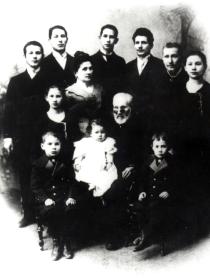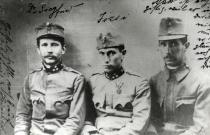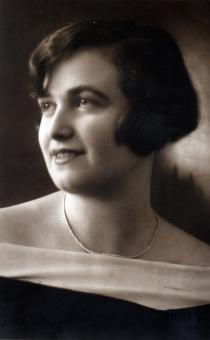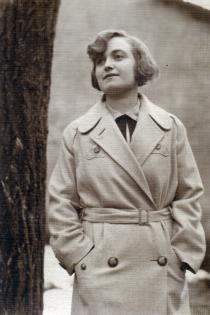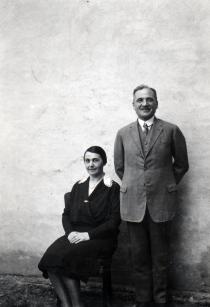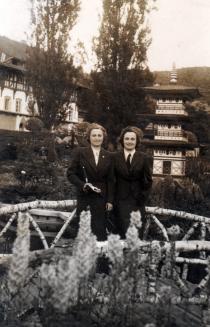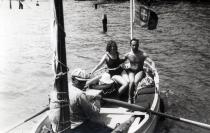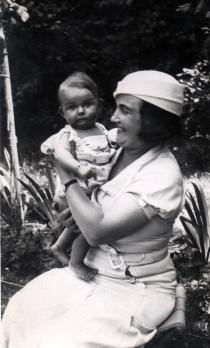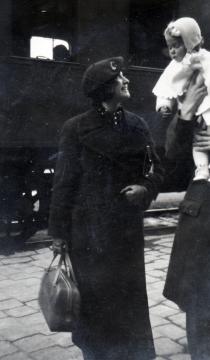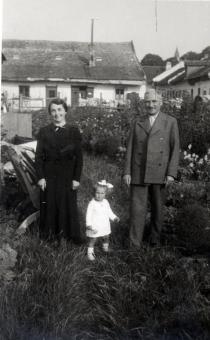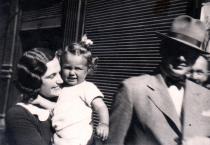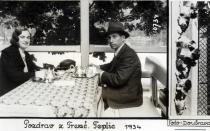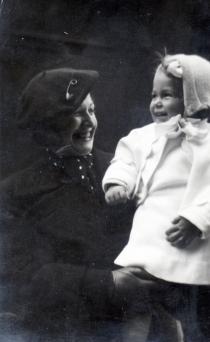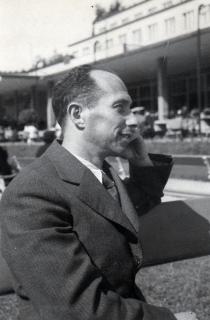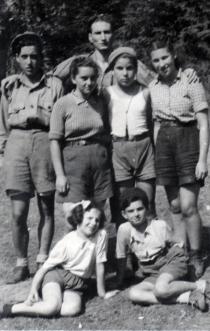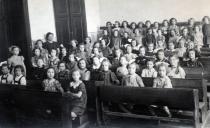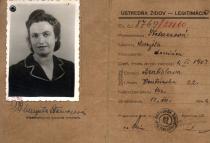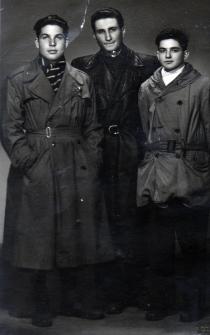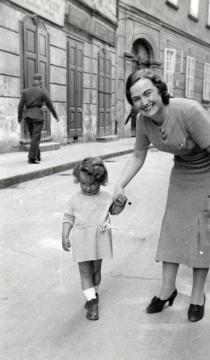
Lydia Piovarcsyova
Bratislava
Slovakia
Family background
I was born on 2nd April 1933 in Bratislava into an urban Jewish family,
whose Bratislava roots date back to the first half of the 19th century. The
Steiner family came to Bratislava in the 18th century. One could say that
our prime began in 1846, when my great-grandfather established a second-
hand bookshop he named after himself, Steiner. Today the store is managed
by my cousin Selma and I'm proud to say that it is one of the most
important cultural centers of Bratislava. It is the heart of the old town,
and the front of the store looks like it did a hundred years ago.
On the Steiner side, I didn't know my great-grandparents. When I was born
they were already dead. My grandfather Sigmund Steiner was born in Kojetin,
then Austria-Hungary, in 1821. As far as I know he was an Orthodox Jew. He
was married to Josephine Steinerova, nee Bendinerova, my grandmother, who
was born in 1814 and died in 1891 in Bratislava. They had a big family; ten
children: Jozef, my father, who died in Auschwitz in 1942, and then my
aunts and uncles Nely, Wilhelm, Moritz, Siegfried, Esperance, Max, Margit,
Gustav and Josefine.
Three Steiner brothers fought as soldiers in World War I. For some military
achievements - I'm not sure what exactly - they were all awarded medals.
The oldest of the three was Doctor Siegfried Steiner, Zelma's father. The
second was Jozef, my father, and the third one was Max, who was later the
owner of the Steiner bookshop along with my father. All the Steiner
brothers and sisters lived in Bratislava, except for their sister Margit,
who is buried in the Orthodox cemetery in Bratislava, next to my
grandmother.
My mother Margita Steiner, nee Abrahamova, was born in Banovce nad
Bebravou. Her father Jakub Abraham was a watchmaker. He was born in Tarnov,
then Austria-Hungary in 1876, came to Slovakia as a businessman and settled
in Zabokreky nad Nitrou. He fell in love with my grandmother Ella, they got
married and lived in Banovce nad Bebravou on the village's beautiful
square. He and my grandmother were both very good-looking people. He was a
Nordic type, blonde with blue eyes. My grandmother was of Spanish origin.
Her family left Spain when the inquisition expelled the Jews; their Spanish
name was Aguilar. She had a typical Spanish appearance, black hair, big
dark eyes and pale skin. In a picture of her, taken when she was fifty, she
looked like Jose Careras. I think they must have had the same ancestors; in
the family there were many singers, even opera singers. Many intellectuals,
university professors, in Vienna and other places, were from that family.
When my grandmother got married they lived in Banovce. From Banovce they
moved to Kezmarok in 1942 to live near their daughter Irenka. They learned
that their son was again wanted by the police and the police wanted to
arrest them as hostages. So they left for Kezmarok to avoid this. Later my
grandmother went to Budapest with Irenka. My grandfather Jakub died during
an operation in 1948; the doctors didn't know that he had high blood
pressure. He is buried in the Orthodox cemetery in Kosice.
My grandparents had a shop and lived with the Weinberger family. There was
a long yard, on one side there was the watchmaker and jewelry shop of my
grandfather, and just opposite was the big grocery store of the
Weinberger's. They were a big family; their daughter was called Renka. All
of them died in the gas chambers in 1942.
My grandparents on my mother's side had three children. The eldest son was
called Viliam. He was an educated man, a pharmacist and a chemist as well.
He was an illegal activist during the war. [Editor's note: He was most
likely an illegal communist] He was hiding, then he was arrested in Ilava
and imprisoned in solitary confinement. He learned several languages there.
He spoke ten languages. When he was released he worked in Smolenice with a
Hungarian pharmaceutical family. He lived there until 1944. He invented a
medicine against chin cough. He gave it to poor children for free. When the
Germans found out, they asked him to give them the medicine. He refused, so
they took him away and deported him to a concentration camp. He died of
typhoid fever in Landsberg concentration camp. I don't know where is it, I
just know that he died there. [Editor's note: Landsberg concentration camp
was situated near munich, today Germany.]
My mother had a twin sister, Irenka, who got married to Mr. Winczer in
Kezmarok. They had a son called Palo. Her husband was killed in a
concentration camp, they threw him down the hill on a pile of stones in a
stone quarry. The boy stayed alone. He lived in Poland for several years
and when they learned he was of Slovak origin from Kezmarok, they contacted
the police and the boy came back to Slovakia. Irenka married for the second
time in Budapest, then she lived in Kosice and died in Bratislava in 1997.
She is buried in the Neolog 1 cemetery in Bratislava under the name
Galambosova. When we went to see Irenka, she needed a lot of nursing: to
iron, to tidy, to do some shopping. There was always very little time, we
were in a hurry and had no time to see the cemetery.
My father was born in 1895 in Bratislava, Slovakia, then Austria-Hungary.
He also ended his life in the Holocaust, in Auschwitz concentration camp in
1942.
Growing up
I often stayed with my grandparents in Banovce nad Bebravou during
holidays. At home I had a nanny because my mother worked. I have to say
that I was never really close to my mother. She never had time for me, so I
don't know much about her.
I studied at an Orthodox Jewish school on Zochova Street in my first and
second years, and Vilma Lowyova was my teacher. I remember one girl from
school. She was an orphan; her name was Kaufmanova. She died in the
Holocaust. We weren't friends. The children played together in groups
according to their social status. Children from better-off families were
grouped together and didn't know the others.
My best friend was Sulamit Nagelova. Her father had an antique shop on
Kapucinska Street, but a library is there nowadays. Sulamit was a blonde
girl with blue eyes and I loved her very much. She also died in the
Holocaust. One girl survived; she was called Ullmanova. One of her
relatives was a journalist. She had wavy hair, was so beautiful and so self-
confident - even as a child. I cannot remember the other children because I
grew up in quite some isolation. I had a nanny and wasn't allowed to play
with other children. I always had to play alone.
On Saturdays we used to visit our family, so I knew my cousins, but I
couldn't play with other children; they couldn't come to see us and I
couldn't really go anywhere. I don't know why it was like this. I had to
speak English at home. I could speak English perfectly then because Zigi's
mother was an Englishwoman and she spoke to me in English only. But I was a
lazy girl and I forgot all my English.
During the war
During the war the Jewish Center was on Kozia Street, in the house where
Mrs. Alexandrova lives today. I have a photograph of my mother taken on
17th July 1941. She looks terribly worried in that picture. My mother was
very pretty, and they used to speak about her as the beauty of Bratislava.
But in this picture her worries are already visible in her features. My
mother died in Auschwitz in 1942.
She filled in the mandatory Jewish identity card with her own handwriting;
she had a very nice handwriting, inherited from her mother. I would like to
donate that photograph to an institution, because I think it has historical
value. I tried to make a copy of it, but the copy wasn't good. The yellow
color of the card must be seen because I think it's symbolical; the
photopaper simply must be yellow.
During the war my grandparents and aunt in Kezmarok took care of me. After
the Slovak National Uprising 2 started and after Slovakia's occupation by
the German army, I stayed in Bratislava. In 1945 I was imprisoned by the
Gestapo and taken to Theresienstadt 3, where I went through atrocities
and sufferings. Finally, after May 1945, I was able to return home.
Post-war
After the Holocaust, I lived with my relatives in Kezmarok. I graduated
from high school in 1952. Later on I enrolled in Economic University in
Prague and graduated in 1957. A few years before that, in 1953, I married
my non-Jewish friend Karol Piovarcsy with whom I have been living until
now. My husband and I returned to Slovakia, to Poprad, where he was
employed by an industrial company. My father's hair was thick and wavy; my
son Karol, born in 1953, inherited it, it's just not as pitch-black as my
father's. And in fact, I inherited it, too. The Steiner family had mostly
wavy hair, a bit African, I suppose you could say. Who knows where we
really come from.
Some members of our family are buried in Kosice, in the Orthodox cemetery.
It's very sad that there is nobody taking care of this cemetery. I've never
been to Kosice since the war. And we've only visited my grandmother's grave
twice.
Not long after the war I visited Banovce with my husband. The house was in
its place, and they even let me see the apartment where my grandparents
used to live. Later, when I was there on a business trip, I was completely
shocked. Not only that the Jews were all gone - everybody perished in the
Holocaust - but they had also destroyed the town. I mean that literally;
even the beautiful square was demolished during the Communist rule. In
Bohemia they would have never demolished such a beautiful square with its
typical one-storied houses. All the shops were owned by Jews.
The Steiner children who survived the Holocaust, apart from me, because I
didn't live in Bratislava are: Cvi, Cipora, Natan, Shoshana, David, Chana,
Jehoshua. All of them live in Israel now, only Cipora died long ago in
Israel. She was married to an Israeli scientist and her daughter is an
artist.
I worked as a high school professor in Poprad. In 1972 we moved with our
two children Karol and Jana, born in 1958, to Bratislava. I worked there
until I retired three years ago. At present, I work at the Bratislava
Jewish Community Center.
Glossary
1 Neolog Jewry
Following a Congress in 1868/69 in Budapest, where theJewish community was supposed to discuss several issues on which the
opinion of the traditionalists and the modernizers differed and which aimed
at uniting Hungarian Jews, Hungarian Jewry was officially split into two
(later three) communities, which all built up their own national community
network. The Neologs were the modernizers, who opposed the Orthodox on
various questions.
2 Slovak National Uprising3 Terezin/Theresienstadt
A ghetto in the Czech Republic, run by the SS.Jews were transferred from there to various extermination camps. It was
used to camouflage the extermination of European Jews by the Nazis, who
presented Theresienstadt as a 'model Jewish settlement'. Czech gendarmes
served as ghetto guards, and with their help the Jews were able to maintain
contact with the outside world. Although education was prohibited, regular
classes were held, clandestinely. Thanks to the large number of artists,
writers, and scholars in the ghetto, there was an intensive program of
cultural activities. At the end of 1943, when word spread of what was
happening in the Nazi camps, the Germans decided to allow an International
Red Cross investigation committee to visit Theresienstadt. In preparation,
more prisoners were deported to Auschwitz, in order to reduce congestion in
the ghetto. Dummy stores, a cafe, a bank, kindergartens, a school, and
flower gardens were put up to deceive the committee.
